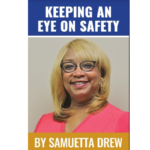By Samuetta Hill Drew
As we begin our third safety article this month on preparedness, I believe it is important to note that September is National Preparedness Month. It is meant to raise awareness about the importance of preparation before a national disaster and/or emergency situation which can occur at any time.
In 2021, FEMA’s Ready Campaign and the Ad Council broke ground by producing the first ever national preparedness campaign. The focus that year was specifically targeted toward the Latino community. This one-of-a-kind campaign was and continues to be committed to putting people first and reaching various communities where they are. These efforts continued in 2022 with the campaign’s primary focus on a call to action for the Black and African American community.
The last two weeks we reviewed home safety measures to use for the maintenance and safety of your home. Where we will continue to review safety preparedness concerns, we will shift our focus slightly using this year’s National Preparedness theme: Take Control in 1,2,3.
The campaign’s focus this year is helping to prepare older adults for disasters, specifically older adults from communities that are disproportionately impacted by the all-hazard events which continue to threaten the nation as well as the world. Our region of the country is constantly impacted by tornadoes, straight line winds, and flash flooding, along with impact from hurricanes coming up from the Gulf. These, along with other unforeseen disasters and emergencies, can be very frightening and extremely disruptive to one’s normal daily life.
We know older adults can face greater risks when it comes to the multitude of extreme weather events and emergencies we now face with global warming. This is especially true for those older adults who live alone, are low income, have a disability, or live in rural areas.
As an older adult, it is vital that you know and understand the specific needs you may have after a disaster. Therefore, we will begin with three simple low-cost steps that can help you better prepare:
- Know what disasters could affect your area of residence which could require evacuation, and when to shelter in place, and plan what you need to do in both cases.
- Keep a NOAA Weather Radio tuned to your local emergency station and monitor TV and radio for warnings about severe weather in your area.
- Download the FEMA app and get weather alerts from the National Weather Service for up to five different locations anywhere in the U.S.
Helping to assist older adults Keep an Eye on Safety is helpful and essential. Next week we will continue this topic with additional safety tips.












